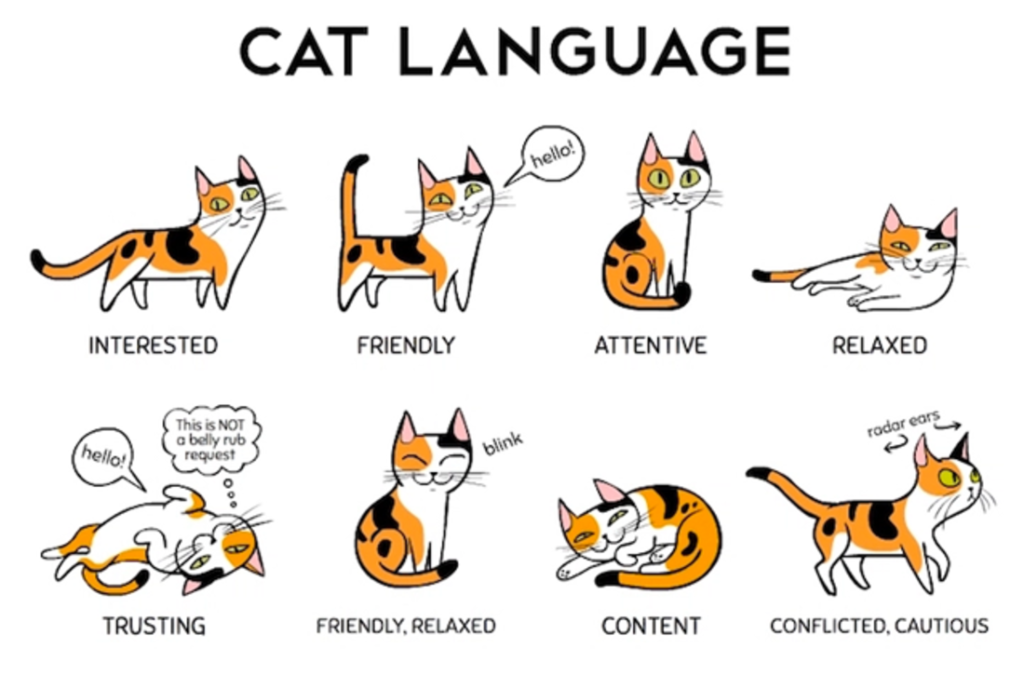Cats are enigmatic creatures with a communication style that’s subtly nuanced yet profoundly expressive. Unlike dogs, who often wear their emotions on their sleeves, cats rely on a complex system of body language to convey their feelings and intentions. Understanding these cues is crucial for fostering a strong bond with your feline companion and ensuring their well-being. Let’s dive into the world of cat body language and decode what your cat is really trying to tell you.

Tail Signals: The Cat’s Mood Meter
The tail is one of the most expressive parts of a cat’s body. A raised tail typically signifies a happy and confident cat, often seen when they greet you or explore new environments. Conversely, a puffed-up tail indicates a frightened or agitated cat, resembling a puffball in an attempt to appear larger and more intimidating.
When a cat’s tail is low and twitching, it might signal irritation or annoyance. If your cat’s tail is flicking rapidly, it’s a sign of agitation or overstimulation. A relaxed tail, gently swaying or lying flat, suggests a calm and content feline.
Ears: The Antennae of Emotions
Cat ears are highly expressive and can provide insight into their emotional state. Forward-facing ears denote curiosity, attentiveness, or affection. If your cat’s ears are pointed sideways or flattened, it’s a sign of fear, aggression, or irritation. Cats may flatten their ears against their head when they’re feeling threatened or are preparing to defend themselves.
Eyes: The Window to Your Cat’s Soul
Cats use their eyes to communicate a range of emotions. Slow blinking, where your cat closes its eyes slowly, is often a sign of trust and contentment. It’s a cat’s way of showing affection and is sometimes referred to as a “cat kiss.” In contrast, dilated pupils can indicate excitement, fear, or aggression, depending on the context. If a cat’s pupils are constricted, it may signal relaxation or irritation.
Whiskers: The Sensory Barometer
A cat’s whiskers are highly sensitive and play a role in their communication. When a cat’s whiskers are extended forward, it generally indicates curiosity or excitement. Whiskers pulled back against the face can signal fear or aggression. These movements help cats gauge their surroundings and express their feelings.
Posture: The Overall Mood Indicator

A cat’s posture provides a comprehensive view of its mood. A cat lying on its back, exposing its belly, is a sign of trust and relaxation. However, don’t interpret this as an invitation for a belly rub, as many cats are sensitive in this area.
An arched back can indicate a defensive posture or a sign of a scared cat trying to make itself look larger. On the other hand, a relaxed, stretched-out posture signifies a content and comfortable cat.
Vocalizations: The Complementary Clues
While body language is the primary mode of communication for cats, vocalizations also play a role. Purring usually signals contentment, though it can also be a sign of discomfort or illness. Meowing is a form of communication with humans rather than other cats and can indicate anything from hunger to a desire for attention.
Grooming and Kneading: Signs of Affection
Grooming is a self-soothing behavior and can also be a way for cats to bond with their human companions. When a cat licks you, it’s often a sign of affection. Kneading, or “making biscuits,” is another behavior linked to comfort and contentment. Cats knead with their paws to create a comforting sensation, similar to how they would knead their mother’s belly as kittens.
Conclusion
Understanding your cat’s body language is key to fostering a deeper connection and ensuring their emotional and physical needs are met. By paying close attention to their tail movements, ear positions, eye expressions, and overall posture, you can better interpret your cat’s feelings and respond accordingly. This insight into their communication will help you create a more harmonious and fulfilling relationship with your feline friend.


